HRM4002 People in Organisations: Leadership, Motivation and Teams
VerifiedAdded on 2023/06/14
|13
|3985
|342
Report
AI Summary
This report examines the critical roles of organisational structure, culture, and leadership in achieving organisational goals, using FitFlop as a case study. It discusses the importance of leadership in guiding employees, the impact of different organisational structures (functional) and cultures (Handy's model), and the significance of transitional change for adapting to dynamic environments. The report further explores employee motivation, referencing Maslow's hierarchy of needs, and highlights the importance of effective teams, drawing on Tuckman's theory of team development. It concludes by emphasizing the interconnectedness of these elements in fostering a productive and positive organisational environment.
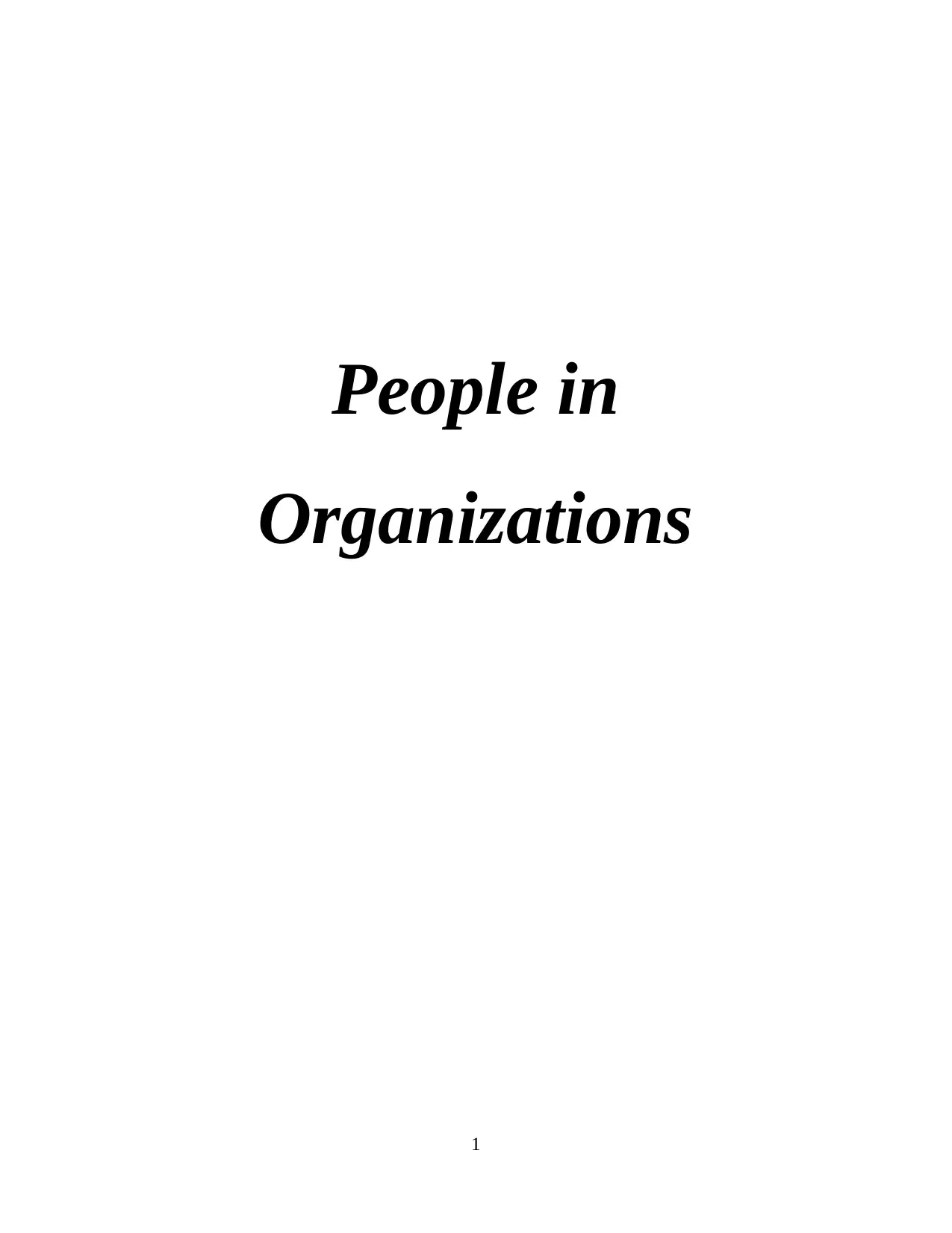
People in
Organizations
1
Organizations
1
Paraphrase This Document
Need a fresh take? Get an instant paraphrase of this document with our AI Paraphraser
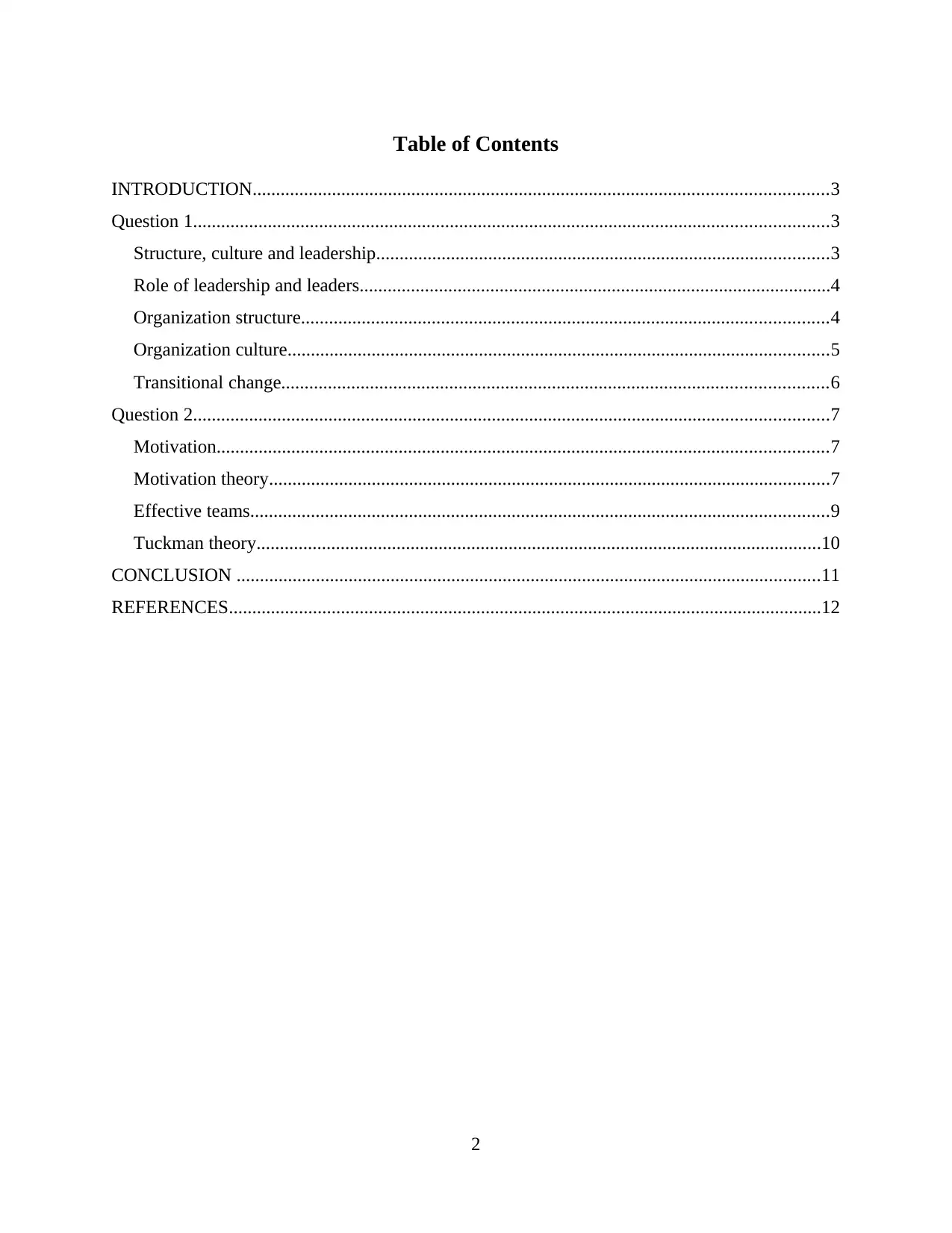
Table of Contents
INTRODUCTION...........................................................................................................................3
Question 1........................................................................................................................................3
Structure, culture and leadership.................................................................................................3
Role of leadership and leaders.....................................................................................................4
Organization structure.................................................................................................................4
Organization culture....................................................................................................................5
Transitional change.....................................................................................................................6
Question 2........................................................................................................................................7
Motivation...................................................................................................................................7
Motivation theory........................................................................................................................7
Effective teams............................................................................................................................9
Tuckman theory.........................................................................................................................10
CONCLUSION .............................................................................................................................11
REFERENCES...............................................................................................................................12
2
INTRODUCTION...........................................................................................................................3
Question 1........................................................................................................................................3
Structure, culture and leadership.................................................................................................3
Role of leadership and leaders.....................................................................................................4
Organization structure.................................................................................................................4
Organization culture....................................................................................................................5
Transitional change.....................................................................................................................6
Question 2........................................................................................................................................7
Motivation...................................................................................................................................7
Motivation theory........................................................................................................................7
Effective teams............................................................................................................................9
Tuckman theory.........................................................................................................................10
CONCLUSION .............................................................................................................................11
REFERENCES...............................................................................................................................12
2
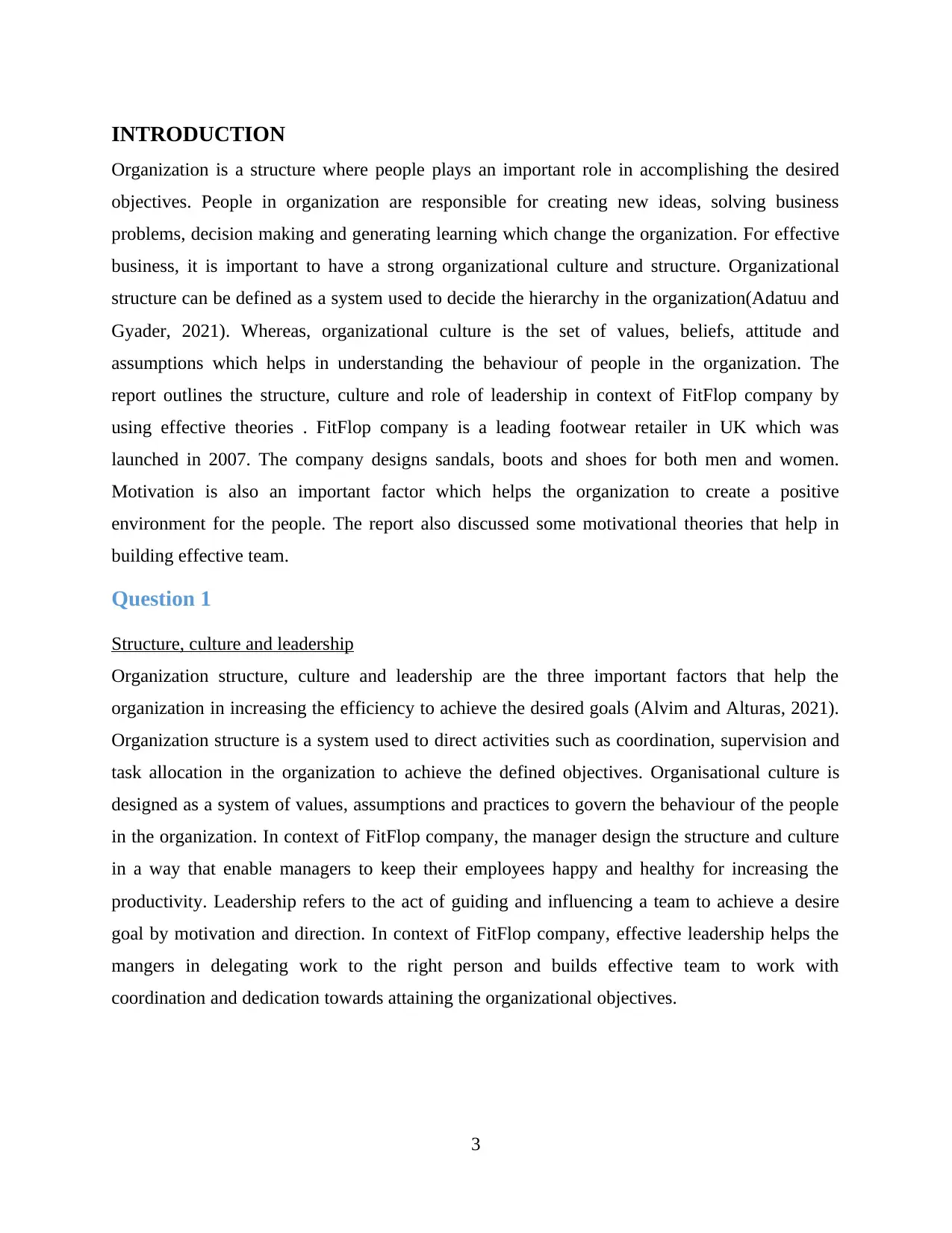
INTRODUCTION
Organization is a structure where people plays an important role in accomplishing the desired
objectives. People in organization are responsible for creating new ideas, solving business
problems, decision making and generating learning which change the organization. For effective
business, it is important to have a strong organizational culture and structure. Organizational
structure can be defined as a system used to decide the hierarchy in the organization(Adatuu and
Gyader, 2021). Whereas, organizational culture is the set of values, beliefs, attitude and
assumptions which helps in understanding the behaviour of people in the organization. The
report outlines the structure, culture and role of leadership in context of FitFlop company by
using effective theories . FitFlop company is a leading footwear retailer in UK which was
launched in 2007. The company designs sandals, boots and shoes for both men and women.
Motivation is also an important factor which helps the organization to create a positive
environment for the people. The report also discussed some motivational theories that help in
building effective team.
Question 1
Structure, culture and leadership
Organization structure, culture and leadership are the three important factors that help the
organization in increasing the efficiency to achieve the desired goals (Alvim and Alturas, 2021).
Organization structure is a system used to direct activities such as coordination, supervision and
task allocation in the organization to achieve the defined objectives. Organisational culture is
designed as a system of values, assumptions and practices to govern the behaviour of the people
in the organization. In context of FitFlop company, the manager design the structure and culture
in a way that enable managers to keep their employees happy and healthy for increasing the
productivity. Leadership refers to the act of guiding and influencing a team to achieve a desire
goal by motivation and direction. In context of FitFlop company, effective leadership helps the
mangers in delegating work to the right person and builds effective team to work with
coordination and dedication towards attaining the organizational objectives.
3
Organization is a structure where people plays an important role in accomplishing the desired
objectives. People in organization are responsible for creating new ideas, solving business
problems, decision making and generating learning which change the organization. For effective
business, it is important to have a strong organizational culture and structure. Organizational
structure can be defined as a system used to decide the hierarchy in the organization(Adatuu and
Gyader, 2021). Whereas, organizational culture is the set of values, beliefs, attitude and
assumptions which helps in understanding the behaviour of people in the organization. The
report outlines the structure, culture and role of leadership in context of FitFlop company by
using effective theories . FitFlop company is a leading footwear retailer in UK which was
launched in 2007. The company designs sandals, boots and shoes for both men and women.
Motivation is also an important factor which helps the organization to create a positive
environment for the people. The report also discussed some motivational theories that help in
building effective team.
Question 1
Structure, culture and leadership
Organization structure, culture and leadership are the three important factors that help the
organization in increasing the efficiency to achieve the desired goals (Alvim and Alturas, 2021).
Organization structure is a system used to direct activities such as coordination, supervision and
task allocation in the organization to achieve the defined objectives. Organisational culture is
designed as a system of values, assumptions and practices to govern the behaviour of the people
in the organization. In context of FitFlop company, the manager design the structure and culture
in a way that enable managers to keep their employees happy and healthy for increasing the
productivity. Leadership refers to the act of guiding and influencing a team to achieve a desire
goal by motivation and direction. In context of FitFlop company, effective leadership helps the
mangers in delegating work to the right person and builds effective team to work with
coordination and dedication towards attaining the organizational objectives.
3
⊘ This is a preview!⊘
Do you want full access?
Subscribe today to unlock all pages.

Trusted by 1+ million students worldwide
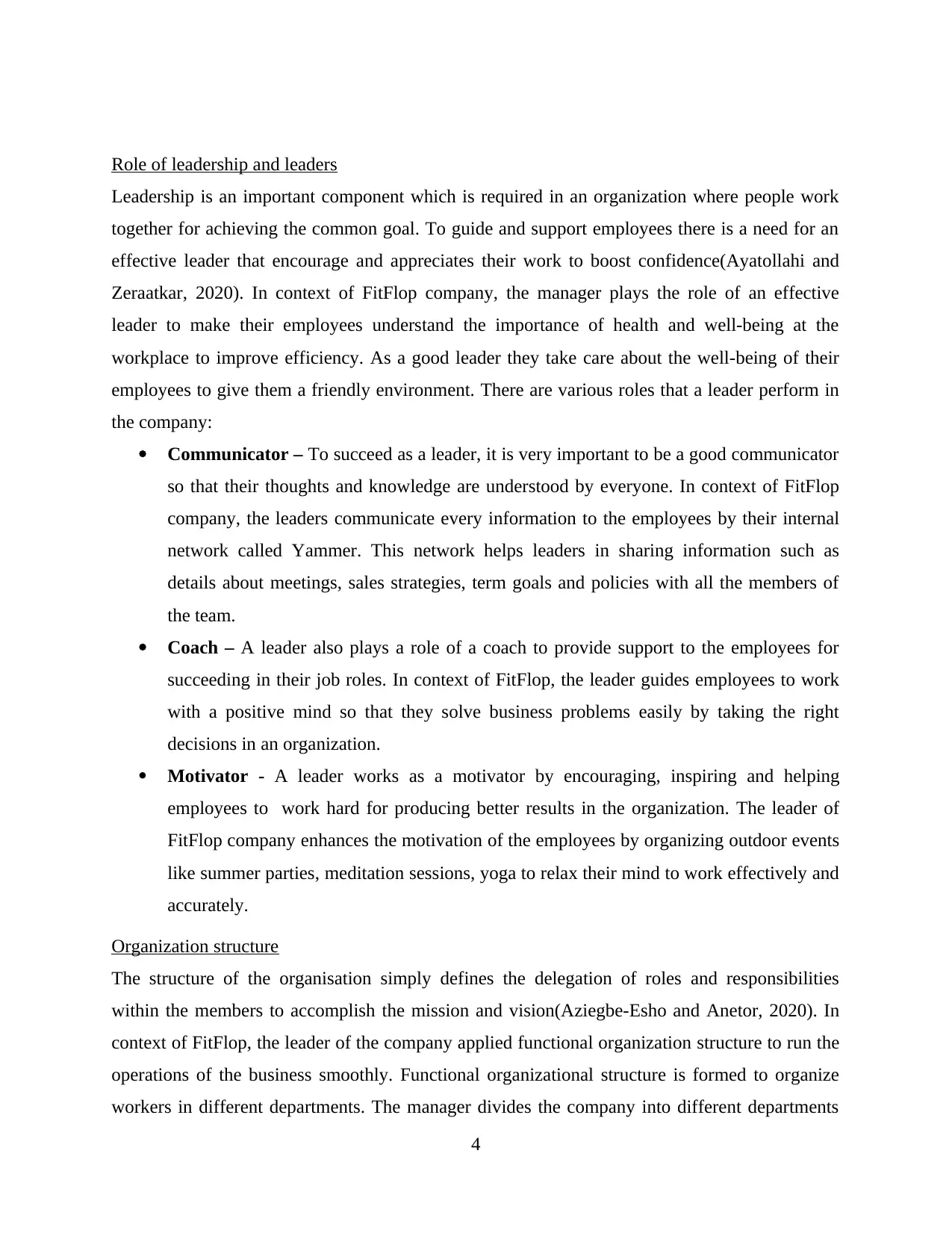
Role of leadership and leaders
Leadership is an important component which is required in an organization where people work
together for achieving the common goal. To guide and support employees there is a need for an
effective leader that encourage and appreciates their work to boost confidence(Ayatollahi and
Zeraatkar, 2020). In context of FitFlop company, the manager plays the role of an effective
leader to make their employees understand the importance of health and well-being at the
workplace to improve efficiency. As a good leader they take care about the well-being of their
employees to give them a friendly environment. There are various roles that a leader perform in
the company:
Communicator – To succeed as a leader, it is very important to be a good communicator
so that their thoughts and knowledge are understood by everyone. In context of FitFlop
company, the leaders communicate every information to the employees by their internal
network called Yammer. This network helps leaders in sharing information such as
details about meetings, sales strategies, term goals and policies with all the members of
the team.
Coach – A leader also plays a role of a coach to provide support to the employees for
succeeding in their job roles. In context of FitFlop, the leader guides employees to work
with a positive mind so that they solve business problems easily by taking the right
decisions in an organization.
Motivator - A leader works as a motivator by encouraging, inspiring and helping
employees to work hard for producing better results in the organization. The leader of
FitFlop company enhances the motivation of the employees by organizing outdoor events
like summer parties, meditation sessions, yoga to relax their mind to work effectively and
accurately.
Organization structure
The structure of the organisation simply defines the delegation of roles and responsibilities
within the members to accomplish the mission and vision(Aziegbe-Esho and Anetor, 2020). In
context of FitFlop, the leader of the company applied functional organization structure to run the
operations of the business smoothly. Functional organizational structure is formed to organize
workers in different departments. The manager divides the company into different departments
4
Leadership is an important component which is required in an organization where people work
together for achieving the common goal. To guide and support employees there is a need for an
effective leader that encourage and appreciates their work to boost confidence(Ayatollahi and
Zeraatkar, 2020). In context of FitFlop company, the manager plays the role of an effective
leader to make their employees understand the importance of health and well-being at the
workplace to improve efficiency. As a good leader they take care about the well-being of their
employees to give them a friendly environment. There are various roles that a leader perform in
the company:
Communicator – To succeed as a leader, it is very important to be a good communicator
so that their thoughts and knowledge are understood by everyone. In context of FitFlop
company, the leaders communicate every information to the employees by their internal
network called Yammer. This network helps leaders in sharing information such as
details about meetings, sales strategies, term goals and policies with all the members of
the team.
Coach – A leader also plays a role of a coach to provide support to the employees for
succeeding in their job roles. In context of FitFlop, the leader guides employees to work
with a positive mind so that they solve business problems easily by taking the right
decisions in an organization.
Motivator - A leader works as a motivator by encouraging, inspiring and helping
employees to work hard for producing better results in the organization. The leader of
FitFlop company enhances the motivation of the employees by organizing outdoor events
like summer parties, meditation sessions, yoga to relax their mind to work effectively and
accurately.
Organization structure
The structure of the organisation simply defines the delegation of roles and responsibilities
within the members to accomplish the mission and vision(Aziegbe-Esho and Anetor, 2020). In
context of FitFlop, the leader of the company applied functional organization structure to run the
operations of the business smoothly. Functional organizational structure is formed to organize
workers in different departments. The manager divides the company into different departments
4
Paraphrase This Document
Need a fresh take? Get an instant paraphrase of this document with our AI Paraphraser
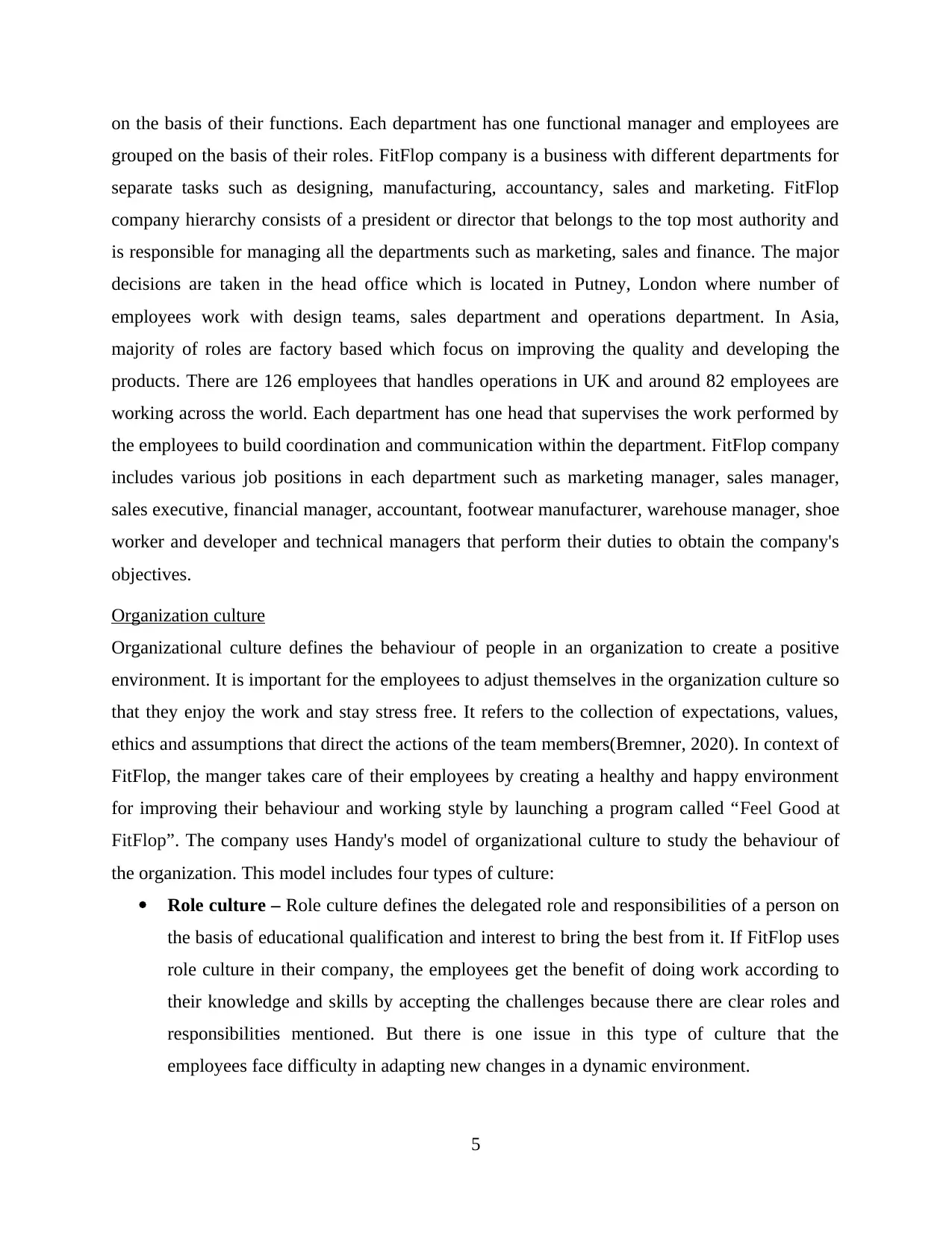
on the basis of their functions. Each department has one functional manager and employees are
grouped on the basis of their roles. FitFlop company is a business with different departments for
separate tasks such as designing, manufacturing, accountancy, sales and marketing. FitFlop
company hierarchy consists of a president or director that belongs to the top most authority and
is responsible for managing all the departments such as marketing, sales and finance. The major
decisions are taken in the head office which is located in Putney, London where number of
employees work with design teams, sales department and operations department. In Asia,
majority of roles are factory based which focus on improving the quality and developing the
products. There are 126 employees that handles operations in UK and around 82 employees are
working across the world. Each department has one head that supervises the work performed by
the employees to build coordination and communication within the department. FitFlop company
includes various job positions in each department such as marketing manager, sales manager,
sales executive, financial manager, accountant, footwear manufacturer, warehouse manager, shoe
worker and developer and technical managers that perform their duties to obtain the company's
objectives.
Organization culture
Organizational culture defines the behaviour of people in an organization to create a positive
environment. It is important for the employees to adjust themselves in the organization culture so
that they enjoy the work and stay stress free. It refers to the collection of expectations, values,
ethics and assumptions that direct the actions of the team members(Bremner, 2020). In context of
FitFlop, the manger takes care of their employees by creating a healthy and happy environment
for improving their behaviour and working style by launching a program called “Feel Good at
FitFlop”. The company uses Handy's model of organizational culture to study the behaviour of
the organization. This model includes four types of culture:
Role culture – Role culture defines the delegated role and responsibilities of a person on
the basis of educational qualification and interest to bring the best from it. If FitFlop uses
role culture in their company, the employees get the benefit of doing work according to
their knowledge and skills by accepting the challenges because there are clear roles and
responsibilities mentioned. But there is one issue in this type of culture that the
employees face difficulty in adapting new changes in a dynamic environment.
5
grouped on the basis of their roles. FitFlop company is a business with different departments for
separate tasks such as designing, manufacturing, accountancy, sales and marketing. FitFlop
company hierarchy consists of a president or director that belongs to the top most authority and
is responsible for managing all the departments such as marketing, sales and finance. The major
decisions are taken in the head office which is located in Putney, London where number of
employees work with design teams, sales department and operations department. In Asia,
majority of roles are factory based which focus on improving the quality and developing the
products. There are 126 employees that handles operations in UK and around 82 employees are
working across the world. Each department has one head that supervises the work performed by
the employees to build coordination and communication within the department. FitFlop company
includes various job positions in each department such as marketing manager, sales manager,
sales executive, financial manager, accountant, footwear manufacturer, warehouse manager, shoe
worker and developer and technical managers that perform their duties to obtain the company's
objectives.
Organization culture
Organizational culture defines the behaviour of people in an organization to create a positive
environment. It is important for the employees to adjust themselves in the organization culture so
that they enjoy the work and stay stress free. It refers to the collection of expectations, values,
ethics and assumptions that direct the actions of the team members(Bremner, 2020). In context of
FitFlop, the manger takes care of their employees by creating a healthy and happy environment
for improving their behaviour and working style by launching a program called “Feel Good at
FitFlop”. The company uses Handy's model of organizational culture to study the behaviour of
the organization. This model includes four types of culture:
Role culture – Role culture defines the delegated role and responsibilities of a person on
the basis of educational qualification and interest to bring the best from it. If FitFlop uses
role culture in their company, the employees get the benefit of doing work according to
their knowledge and skills by accepting the challenges because there are clear roles and
responsibilities mentioned. But there is one issue in this type of culture that the
employees face difficulty in adapting new changes in a dynamic environment.
5
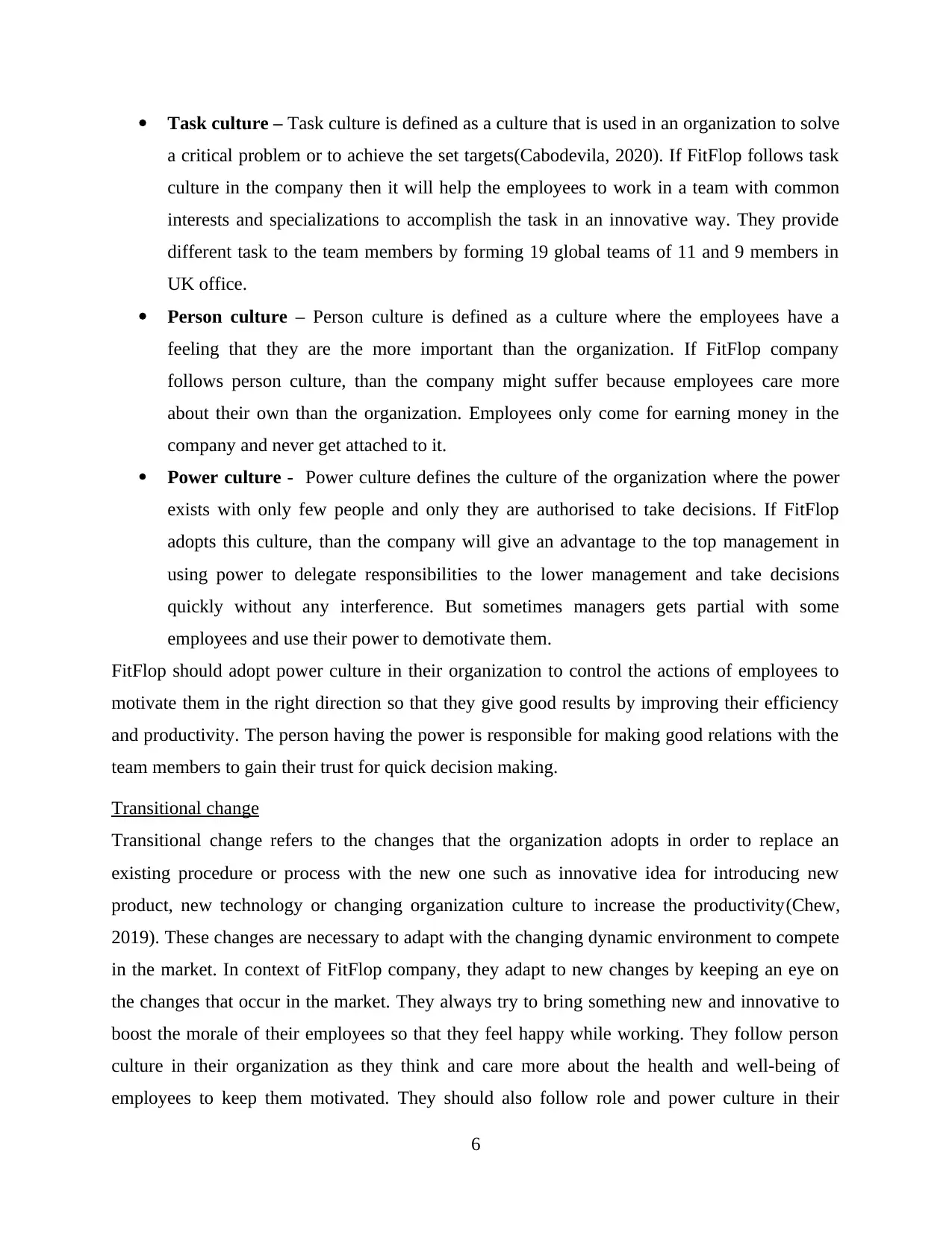
Task culture – Task culture is defined as a culture that is used in an organization to solve
a critical problem or to achieve the set targets(Cabodevila, 2020). If FitFlop follows task
culture in the company then it will help the employees to work in a team with common
interests and specializations to accomplish the task in an innovative way. They provide
different task to the team members by forming 19 global teams of 11 and 9 members in
UK office.
Person culture – Person culture is defined as a culture where the employees have a
feeling that they are the more important than the organization. If FitFlop company
follows person culture, than the company might suffer because employees care more
about their own than the organization. Employees only come for earning money in the
company and never get attached to it.
Power culture - Power culture defines the culture of the organization where the power
exists with only few people and only they are authorised to take decisions. If FitFlop
adopts this culture, than the company will give an advantage to the top management in
using power to delegate responsibilities to the lower management and take decisions
quickly without any interference. But sometimes managers gets partial with some
employees and use their power to demotivate them.
FitFlop should adopt power culture in their organization to control the actions of employees to
motivate them in the right direction so that they give good results by improving their efficiency
and productivity. The person having the power is responsible for making good relations with the
team members to gain their trust for quick decision making.
Transitional change
Transitional change refers to the changes that the organization adopts in order to replace an
existing procedure or process with the new one such as innovative idea for introducing new
product, new technology or changing organization culture to increase the productivity(Chew,
2019). These changes are necessary to adapt with the changing dynamic environment to compete
in the market. In context of FitFlop company, they adapt to new changes by keeping an eye on
the changes that occur in the market. They always try to bring something new and innovative to
boost the morale of their employees so that they feel happy while working. They follow person
culture in their organization as they think and care more about the health and well-being of
employees to keep them motivated. They should also follow role and power culture in their
6
a critical problem or to achieve the set targets(Cabodevila, 2020). If FitFlop follows task
culture in the company then it will help the employees to work in a team with common
interests and specializations to accomplish the task in an innovative way. They provide
different task to the team members by forming 19 global teams of 11 and 9 members in
UK office.
Person culture – Person culture is defined as a culture where the employees have a
feeling that they are the more important than the organization. If FitFlop company
follows person culture, than the company might suffer because employees care more
about their own than the organization. Employees only come for earning money in the
company and never get attached to it.
Power culture - Power culture defines the culture of the organization where the power
exists with only few people and only they are authorised to take decisions. If FitFlop
adopts this culture, than the company will give an advantage to the top management in
using power to delegate responsibilities to the lower management and take decisions
quickly without any interference. But sometimes managers gets partial with some
employees and use their power to demotivate them.
FitFlop should adopt power culture in their organization to control the actions of employees to
motivate them in the right direction so that they give good results by improving their efficiency
and productivity. The person having the power is responsible for making good relations with the
team members to gain their trust for quick decision making.
Transitional change
Transitional change refers to the changes that the organization adopts in order to replace an
existing procedure or process with the new one such as innovative idea for introducing new
product, new technology or changing organization culture to increase the productivity(Chew,
2019). These changes are necessary to adapt with the changing dynamic environment to compete
in the market. In context of FitFlop company, they adapt to new changes by keeping an eye on
the changes that occur in the market. They always try to bring something new and innovative to
boost the morale of their employees so that they feel happy while working. They follow person
culture in their organization as they think and care more about the health and well-being of
employees to keep them motivated. They should also follow role and power culture in their
6
⊘ This is a preview!⊘
Do you want full access?
Subscribe today to unlock all pages.

Trusted by 1+ million students worldwide
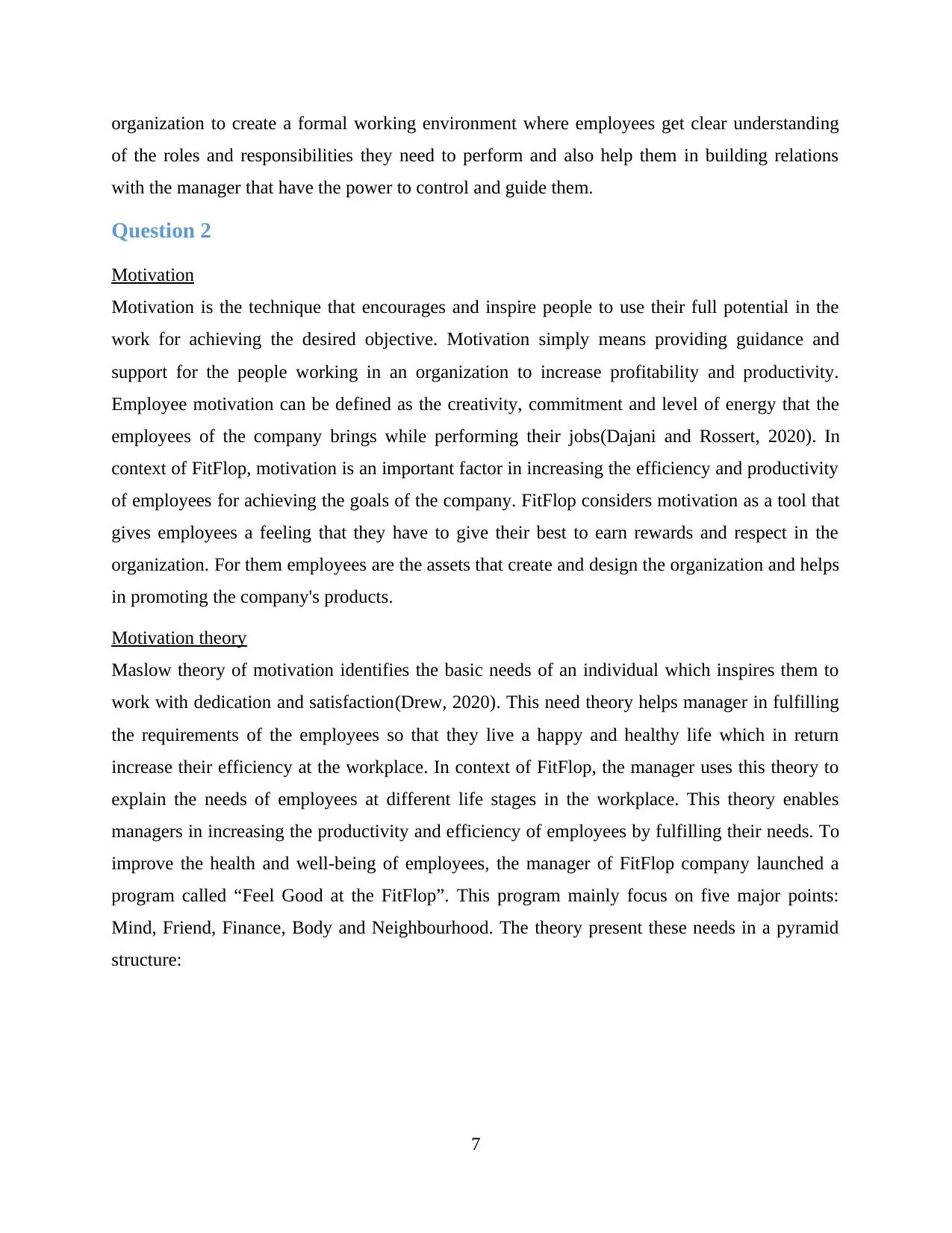
organization to create a formal working environment where employees get clear understanding
of the roles and responsibilities they need to perform and also help them in building relations
with the manager that have the power to control and guide them.
Question 2
Motivation
Motivation is the technique that encourages and inspire people to use their full potential in the
work for achieving the desired objective. Motivation simply means providing guidance and
support for the people working in an organization to increase profitability and productivity.
Employee motivation can be defined as the creativity, commitment and level of energy that the
employees of the company brings while performing their jobs(Dajani and Rossert, 2020). In
context of FitFlop, motivation is an important factor in increasing the efficiency and productivity
of employees for achieving the goals of the company. FitFlop considers motivation as a tool that
gives employees a feeling that they have to give their best to earn rewards and respect in the
organization. For them employees are the assets that create and design the organization and helps
in promoting the company's products.
Motivation theory
Maslow theory of motivation identifies the basic needs of an individual which inspires them to
work with dedication and satisfaction(Drew, 2020). This need theory helps manager in fulfilling
the requirements of the employees so that they live a happy and healthy life which in return
increase their efficiency at the workplace. In context of FitFlop, the manager uses this theory to
explain the needs of employees at different life stages in the workplace. This theory enables
managers in increasing the productivity and efficiency of employees by fulfilling their needs. To
improve the health and well-being of employees, the manager of FitFlop company launched a
program called “Feel Good at the FitFlop”. This program mainly focus on five major points:
Mind, Friend, Finance, Body and Neighbourhood. The theory present these needs in a pyramid
structure:
7
of the roles and responsibilities they need to perform and also help them in building relations
with the manager that have the power to control and guide them.
Question 2
Motivation
Motivation is the technique that encourages and inspire people to use their full potential in the
work for achieving the desired objective. Motivation simply means providing guidance and
support for the people working in an organization to increase profitability and productivity.
Employee motivation can be defined as the creativity, commitment and level of energy that the
employees of the company brings while performing their jobs(Dajani and Rossert, 2020). In
context of FitFlop, motivation is an important factor in increasing the efficiency and productivity
of employees for achieving the goals of the company. FitFlop considers motivation as a tool that
gives employees a feeling that they have to give their best to earn rewards and respect in the
organization. For them employees are the assets that create and design the organization and helps
in promoting the company's products.
Motivation theory
Maslow theory of motivation identifies the basic needs of an individual which inspires them to
work with dedication and satisfaction(Drew, 2020). This need theory helps manager in fulfilling
the requirements of the employees so that they live a happy and healthy life which in return
increase their efficiency at the workplace. In context of FitFlop, the manager uses this theory to
explain the needs of employees at different life stages in the workplace. This theory enables
managers in increasing the productivity and efficiency of employees by fulfilling their needs. To
improve the health and well-being of employees, the manager of FitFlop company launched a
program called “Feel Good at the FitFlop”. This program mainly focus on five major points:
Mind, Friend, Finance, Body and Neighbourhood. The theory present these needs in a pyramid
structure:
7
Paraphrase This Document
Need a fresh take? Get an instant paraphrase of this document with our AI Paraphraser
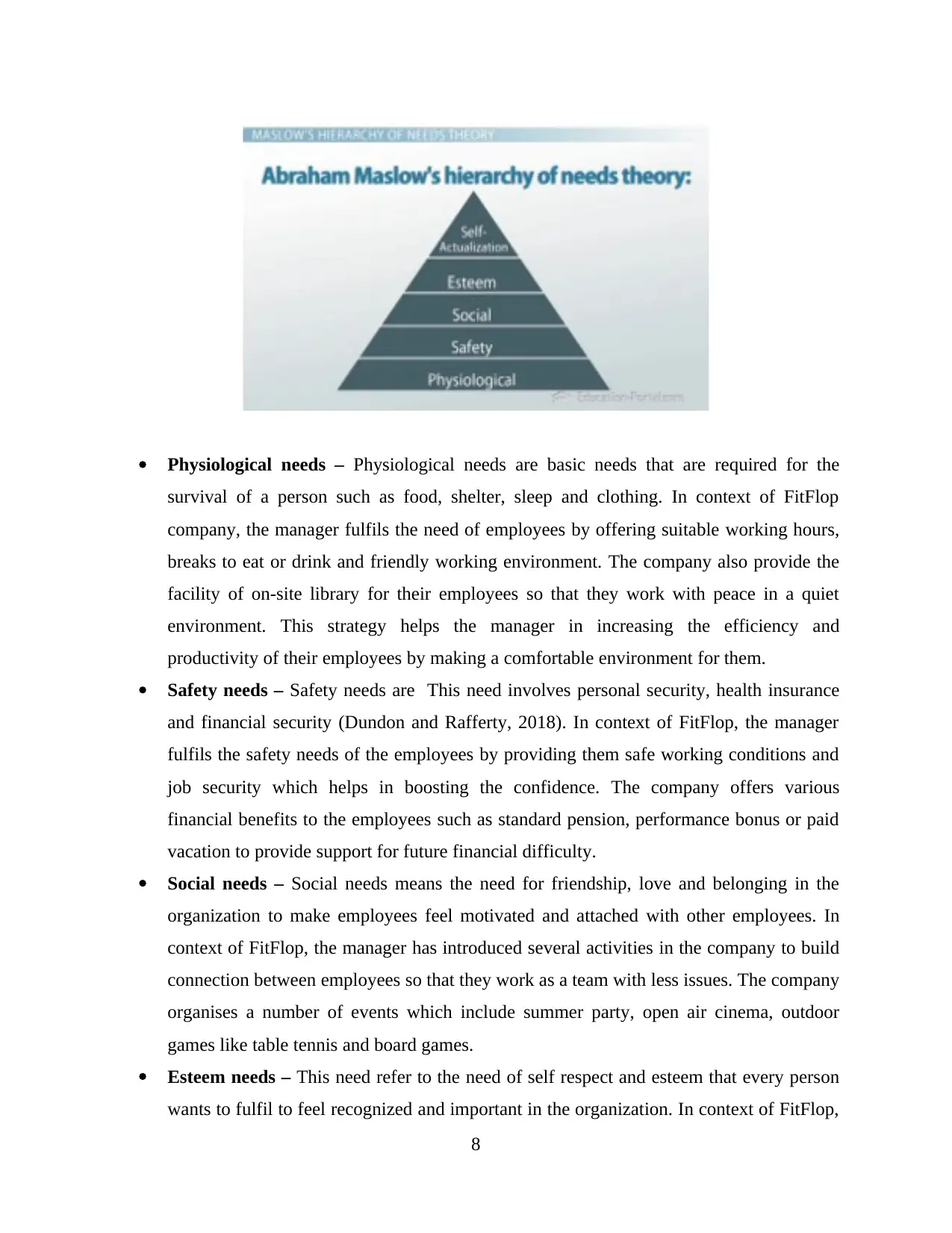
Physiological needs – Physiological needs are basic needs that are required for the
survival of a person such as food, shelter, sleep and clothing. In context of FitFlop
company, the manager fulfils the need of employees by offering suitable working hours,
breaks to eat or drink and friendly working environment. The company also provide the
facility of on-site library for their employees so that they work with peace in a quiet
environment. This strategy helps the manager in increasing the efficiency and
productivity of their employees by making a comfortable environment for them.
Safety needs – Safety needs are This need involves personal security, health insurance
and financial security (Dundon and Rafferty, 2018). In context of FitFlop, the manager
fulfils the safety needs of the employees by providing them safe working conditions and
job security which helps in boosting the confidence. The company offers various
financial benefits to the employees such as standard pension, performance bonus or paid
vacation to provide support for future financial difficulty.
Social needs – Social needs means the need for friendship, love and belonging in the
organization to make employees feel motivated and attached with other employees. In
context of FitFlop, the manager has introduced several activities in the company to build
connection between employees so that they work as a team with less issues. The company
organises a number of events which include summer party, open air cinema, outdoor
games like table tennis and board games.
Esteem needs – This need refer to the need of self respect and esteem that every person
wants to fulfil to feel recognized and important in the organization. In context of FitFlop,
8
survival of a person such as food, shelter, sleep and clothing. In context of FitFlop
company, the manager fulfils the need of employees by offering suitable working hours,
breaks to eat or drink and friendly working environment. The company also provide the
facility of on-site library for their employees so that they work with peace in a quiet
environment. This strategy helps the manager in increasing the efficiency and
productivity of their employees by making a comfortable environment for them.
Safety needs – Safety needs are This need involves personal security, health insurance
and financial security (Dundon and Rafferty, 2018). In context of FitFlop, the manager
fulfils the safety needs of the employees by providing them safe working conditions and
job security which helps in boosting the confidence. The company offers various
financial benefits to the employees such as standard pension, performance bonus or paid
vacation to provide support for future financial difficulty.
Social needs – Social needs means the need for friendship, love and belonging in the
organization to make employees feel motivated and attached with other employees. In
context of FitFlop, the manager has introduced several activities in the company to build
connection between employees so that they work as a team with less issues. The company
organises a number of events which include summer party, open air cinema, outdoor
games like table tennis and board games.
Esteem needs – This need refer to the need of self respect and esteem that every person
wants to fulfil to feel recognized and important in the organization. In context of FitFlop,
8
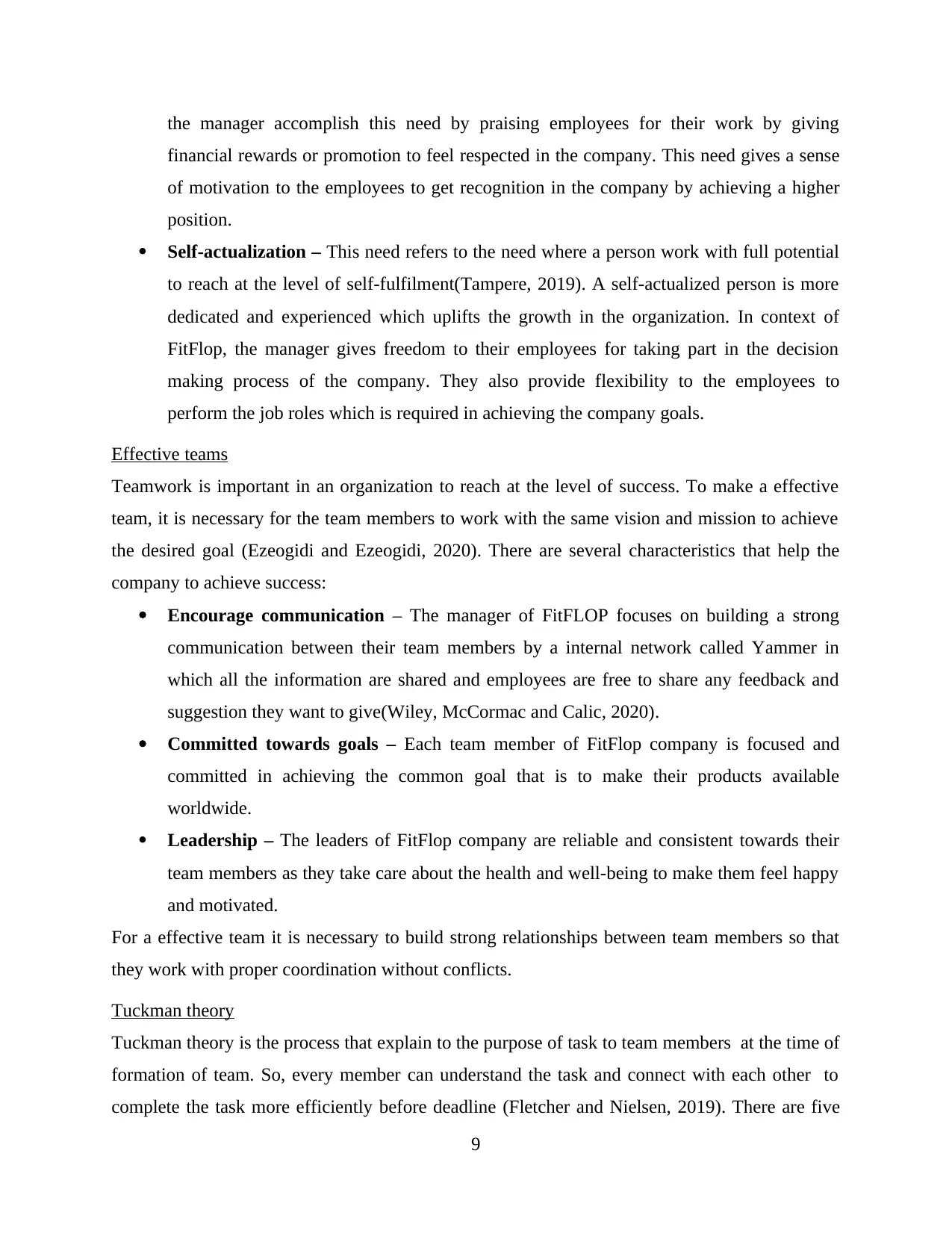
the manager accomplish this need by praising employees for their work by giving
financial rewards or promotion to feel respected in the company. This need gives a sense
of motivation to the employees to get recognition in the company by achieving a higher
position.
Self-actualization – This need refers to the need where a person work with full potential
to reach at the level of self-fulfilment(Tampere, 2019). A self-actualized person is more
dedicated and experienced which uplifts the growth in the organization. In context of
FitFlop, the manager gives freedom to their employees for taking part in the decision
making process of the company. They also provide flexibility to the employees to
perform the job roles which is required in achieving the company goals.
Effective teams
Teamwork is important in an organization to reach at the level of success. To make a effective
team, it is necessary for the team members to work with the same vision and mission to achieve
the desired goal (Ezeogidi and Ezeogidi, 2020). There are several characteristics that help the
company to achieve success:
Encourage communication – The manager of FitFLOP focuses on building a strong
communication between their team members by a internal network called Yammer in
which all the information are shared and employees are free to share any feedback and
suggestion they want to give(Wiley, McCormac and Calic, 2020).
Committed towards goals – Each team member of FitFlop company is focused and
committed in achieving the common goal that is to make their products available
worldwide.
Leadership – The leaders of FitFlop company are reliable and consistent towards their
team members as they take care about the health and well-being to make them feel happy
and motivated.
For a effective team it is necessary to build strong relationships between team members so that
they work with proper coordination without conflicts.
Tuckman theory
Tuckman theory is the process that explain to the purpose of task to team members at the time of
formation of team. So, every member can understand the task and connect with each other to
complete the task more efficiently before deadline (Fletcher and Nielsen, 2019). There are five
9
financial rewards or promotion to feel respected in the company. This need gives a sense
of motivation to the employees to get recognition in the company by achieving a higher
position.
Self-actualization – This need refers to the need where a person work with full potential
to reach at the level of self-fulfilment(Tampere, 2019). A self-actualized person is more
dedicated and experienced which uplifts the growth in the organization. In context of
FitFlop, the manager gives freedom to their employees for taking part in the decision
making process of the company. They also provide flexibility to the employees to
perform the job roles which is required in achieving the company goals.
Effective teams
Teamwork is important in an organization to reach at the level of success. To make a effective
team, it is necessary for the team members to work with the same vision and mission to achieve
the desired goal (Ezeogidi and Ezeogidi, 2020). There are several characteristics that help the
company to achieve success:
Encourage communication – The manager of FitFLOP focuses on building a strong
communication between their team members by a internal network called Yammer in
which all the information are shared and employees are free to share any feedback and
suggestion they want to give(Wiley, McCormac and Calic, 2020).
Committed towards goals – Each team member of FitFlop company is focused and
committed in achieving the common goal that is to make their products available
worldwide.
Leadership – The leaders of FitFlop company are reliable and consistent towards their
team members as they take care about the health and well-being to make them feel happy
and motivated.
For a effective team it is necessary to build strong relationships between team members so that
they work with proper coordination without conflicts.
Tuckman theory
Tuckman theory is the process that explain to the purpose of task to team members at the time of
formation of team. So, every member can understand the task and connect with each other to
complete the task more efficiently before deadline (Fletcher and Nielsen, 2019). There are five
9
⊘ This is a preview!⊘
Do you want full access?
Subscribe today to unlock all pages.

Trusted by 1+ million students worldwide
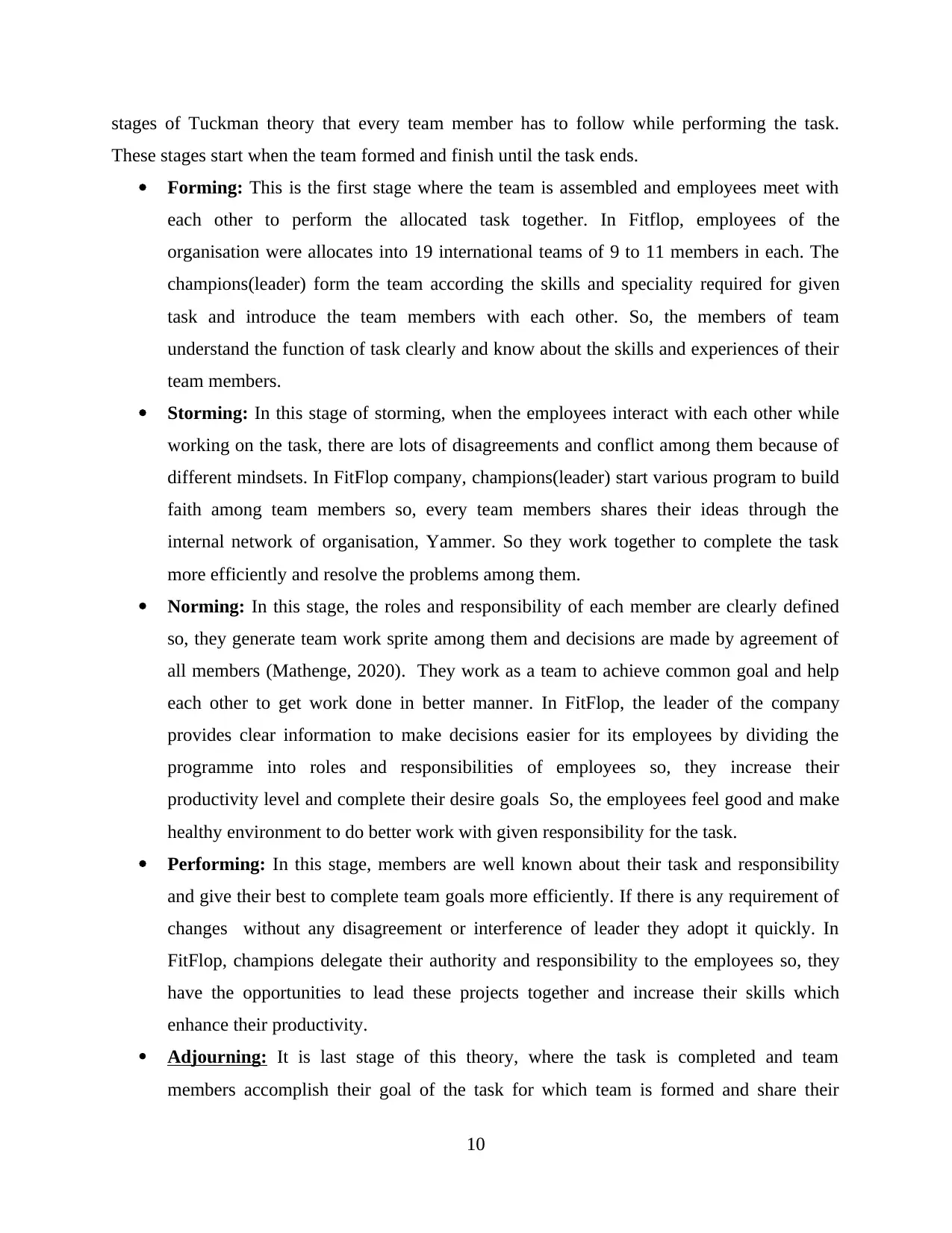
stages of Tuckman theory that every team member has to follow while performing the task.
These stages start when the team formed and finish until the task ends.
Forming: This is the first stage where the team is assembled and employees meet with
each other to perform the allocated task together. In Fitflop, employees of the
organisation were allocates into 19 international teams of 9 to 11 members in each. The
champions(leader) form the team according the skills and speciality required for given
task and introduce the team members with each other. So, the members of team
understand the function of task clearly and know about the skills and experiences of their
team members.
Storming: In this stage of storming, when the employees interact with each other while
working on the task, there are lots of disagreements and conflict among them because of
different mindsets. In FitFlop company, champions(leader) start various program to build
faith among team members so, every team members shares their ideas through the
internal network of organisation, Yammer. So they work together to complete the task
more efficiently and resolve the problems among them.
Norming: In this stage, the roles and responsibility of each member are clearly defined
so, they generate team work sprite among them and decisions are made by agreement of
all members (Mathenge, 2020). They work as a team to achieve common goal and help
each other to get work done in better manner. In FitFlop, the leader of the company
provides clear information to make decisions easier for its employees by dividing the
programme into roles and responsibilities of employees so, they increase their
productivity level and complete their desire goals So, the employees feel good and make
healthy environment to do better work with given responsibility for the task.
Performing: In this stage, members are well known about their task and responsibility
and give their best to complete team goals more efficiently. If there is any requirement of
changes without any disagreement or interference of leader they adopt it quickly. In
FitFlop, champions delegate their authority and responsibility to the employees so, they
have the opportunities to lead these projects together and increase their skills which
enhance their productivity.
Adjourning: It is last stage of this theory, where the task is completed and team
members accomplish their goal of the task for which team is formed and share their
10
These stages start when the team formed and finish until the task ends.
Forming: This is the first stage where the team is assembled and employees meet with
each other to perform the allocated task together. In Fitflop, employees of the
organisation were allocates into 19 international teams of 9 to 11 members in each. The
champions(leader) form the team according the skills and speciality required for given
task and introduce the team members with each other. So, the members of team
understand the function of task clearly and know about the skills and experiences of their
team members.
Storming: In this stage of storming, when the employees interact with each other while
working on the task, there are lots of disagreements and conflict among them because of
different mindsets. In FitFlop company, champions(leader) start various program to build
faith among team members so, every team members shares their ideas through the
internal network of organisation, Yammer. So they work together to complete the task
more efficiently and resolve the problems among them.
Norming: In this stage, the roles and responsibility of each member are clearly defined
so, they generate team work sprite among them and decisions are made by agreement of
all members (Mathenge, 2020). They work as a team to achieve common goal and help
each other to get work done in better manner. In FitFlop, the leader of the company
provides clear information to make decisions easier for its employees by dividing the
programme into roles and responsibilities of employees so, they increase their
productivity level and complete their desire goals So, the employees feel good and make
healthy environment to do better work with given responsibility for the task.
Performing: In this stage, members are well known about their task and responsibility
and give their best to complete team goals more efficiently. If there is any requirement of
changes without any disagreement or interference of leader they adopt it quickly. In
FitFlop, champions delegate their authority and responsibility to the employees so, they
have the opportunities to lead these projects together and increase their skills which
enhance their productivity.
Adjourning: It is last stage of this theory, where the task is completed and team
members accomplish their goal of the task for which team is formed and share their
10
Paraphrase This Document
Need a fresh take? Get an instant paraphrase of this document with our AI Paraphraser
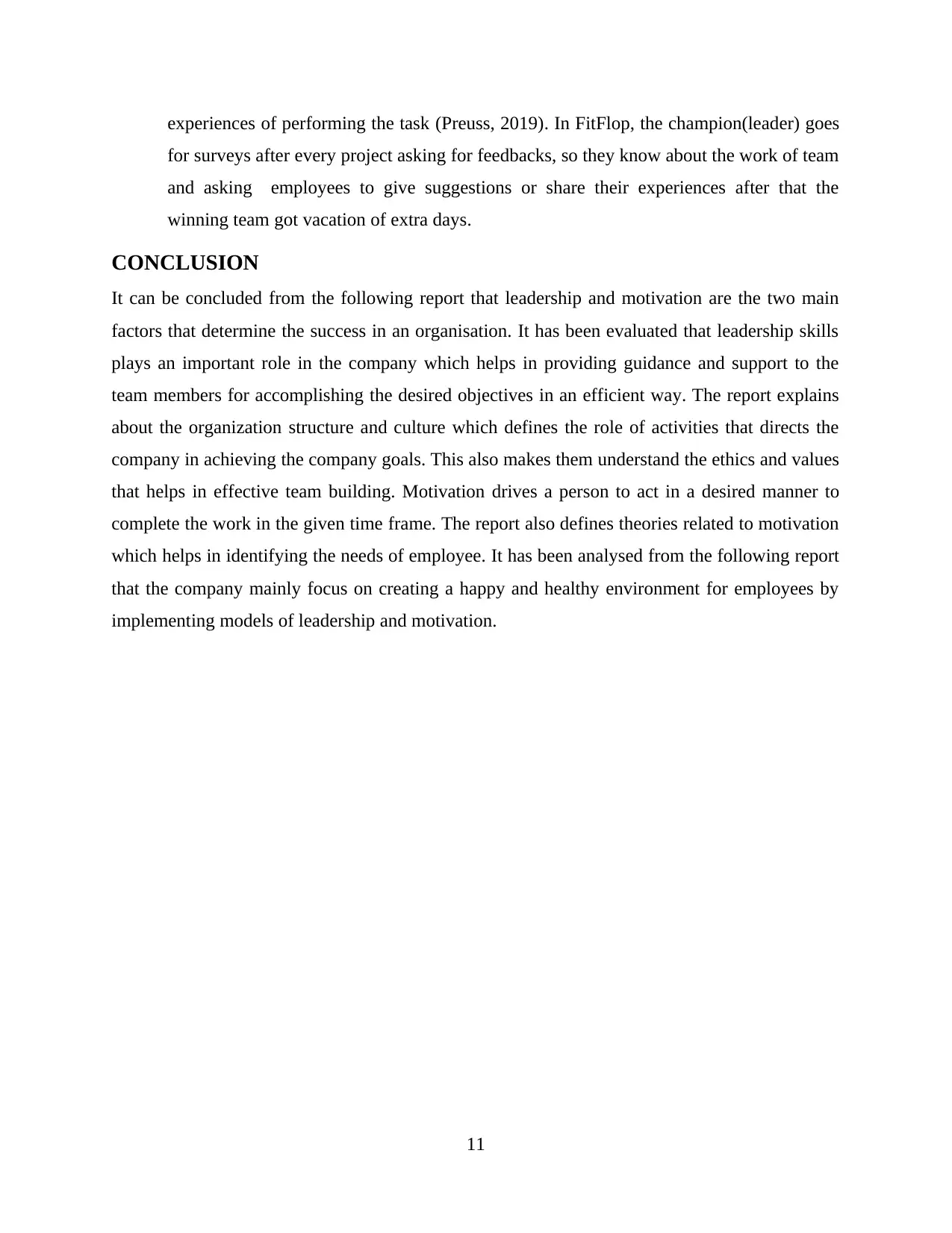
experiences of performing the task (Preuss, 2019). In FitFlop, the champion(leader) goes
for surveys after every project asking for feedbacks, so they know about the work of team
and asking employees to give suggestions or share their experiences after that the
winning team got vacation of extra days.
CONCLUSION
It can be concluded from the following report that leadership and motivation are the two main
factors that determine the success in an organisation. It has been evaluated that leadership skills
plays an important role in the company which helps in providing guidance and support to the
team members for accomplishing the desired objectives in an efficient way. The report explains
about the organization structure and culture which defines the role of activities that directs the
company in achieving the company goals. This also makes them understand the ethics and values
that helps in effective team building. Motivation drives a person to act in a desired manner to
complete the work in the given time frame. The report also defines theories related to motivation
which helps in identifying the needs of employee. It has been analysed from the following report
that the company mainly focus on creating a happy and healthy environment for employees by
implementing models of leadership and motivation.
11
for surveys after every project asking for feedbacks, so they know about the work of team
and asking employees to give suggestions or share their experiences after that the
winning team got vacation of extra days.
CONCLUSION
It can be concluded from the following report that leadership and motivation are the two main
factors that determine the success in an organisation. It has been evaluated that leadership skills
plays an important role in the company which helps in providing guidance and support to the
team members for accomplishing the desired objectives in an efficient way. The report explains
about the organization structure and culture which defines the role of activities that directs the
company in achieving the company goals. This also makes them understand the ethics and values
that helps in effective team building. Motivation drives a person to act in a desired manner to
complete the work in the given time frame. The report also defines theories related to motivation
which helps in identifying the needs of employee. It has been analysed from the following report
that the company mainly focus on creating a happy and healthy environment for employees by
implementing models of leadership and motivation.
11
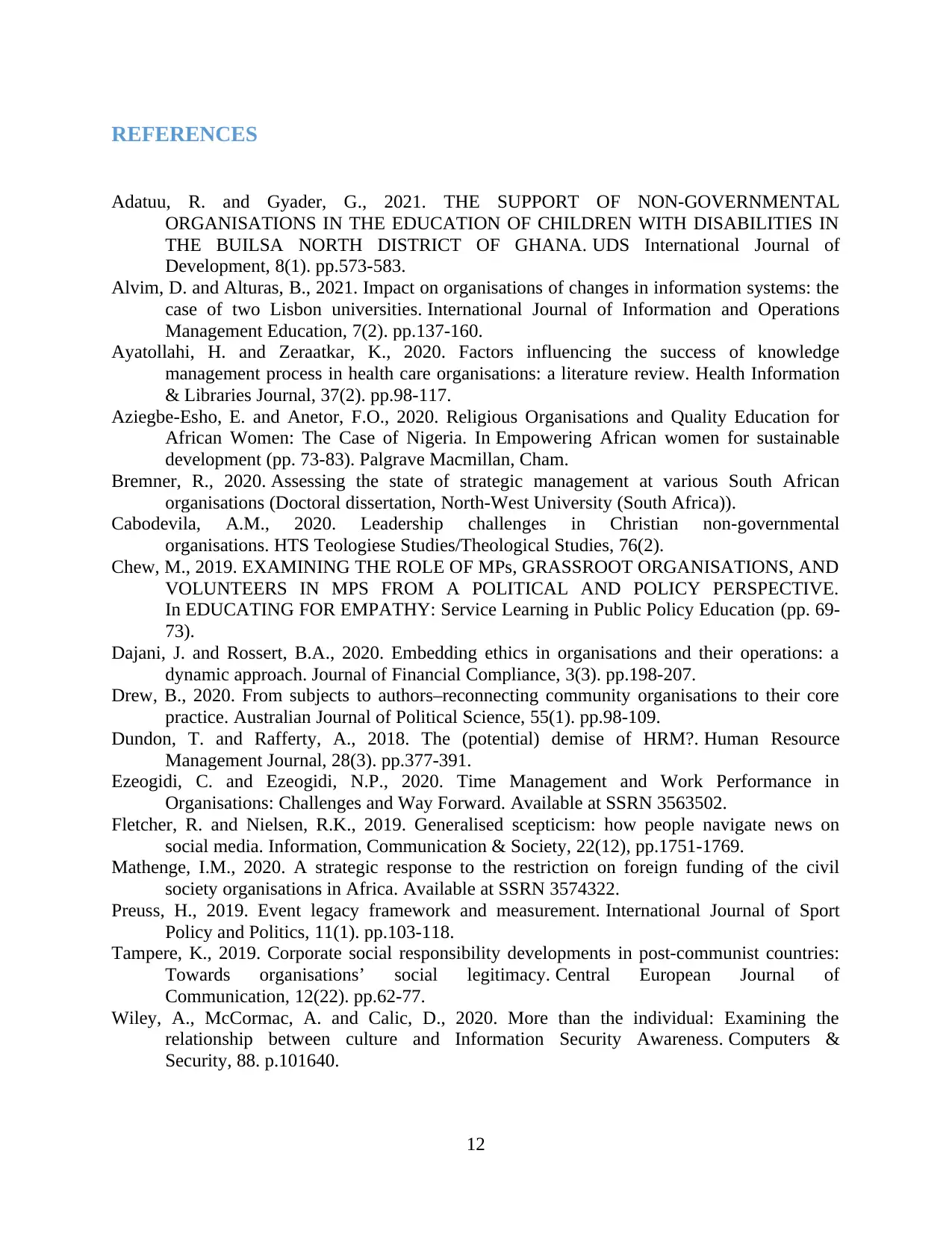
REFERENCES
Adatuu, R. and Gyader, G., 2021. THE SUPPORT OF NON-GOVERNMENTAL
ORGANISATIONS IN THE EDUCATION OF CHILDREN WITH DISABILITIES IN
THE BUILSA NORTH DISTRICT OF GHANA. UDS International Journal of
Development, 8(1). pp.573-583.
Alvim, D. and Alturas, B., 2021. Impact on organisations of changes in information systems: the
case of two Lisbon universities. International Journal of Information and Operations
Management Education, 7(2). pp.137-160.
Ayatollahi, H. and Zeraatkar, K., 2020. Factors influencing the success of knowledge
management process in health care organisations: a literature review. Health Information
& Libraries Journal, 37(2). pp.98-117.
Aziegbe-Esho, E. and Anetor, F.O., 2020. Religious Organisations and Quality Education for
African Women: The Case of Nigeria. In Empowering African women for sustainable
development (pp. 73-83). Palgrave Macmillan, Cham.
Bremner, R., 2020. Assessing the state of strategic management at various South African
organisations (Doctoral dissertation, North-West University (South Africa)).
Cabodevila, A.M., 2020. Leadership challenges in Christian non-governmental
organisations. HTS Teologiese Studies/Theological Studies, 76(2).
Chew, M., 2019. EXAMINING THE ROLE OF MPs, GRASSROOT ORGANISATIONS, AND
VOLUNTEERS IN MPS FROM A POLITICAL AND POLICY PERSPECTIVE.
In EDUCATING FOR EMPATHY: Service Learning in Public Policy Education (pp. 69-
73).
Dajani, J. and Rossert, B.A., 2020. Embedding ethics in organisations and their operations: a
dynamic approach. Journal of Financial Compliance, 3(3). pp.198-207.
Drew, B., 2020. From subjects to authors–reconnecting community organisations to their core
practice. Australian Journal of Political Science, 55(1). pp.98-109.
Dundon, T. and Rafferty, A., 2018. The (potential) demise of HRM?. Human Resource
Management Journal, 28(3). pp.377-391.
Ezeogidi, C. and Ezeogidi, N.P., 2020. Time Management and Work Performance in
Organisations: Challenges and Way Forward. Available at SSRN 3563502.
Fletcher, R. and Nielsen, R.K., 2019. Generalised scepticism: how people navigate news on
social media. Information, Communication & Society, 22(12), pp.1751-1769.
Mathenge, I.M., 2020. A strategic response to the restriction on foreign funding of the civil
society organisations in Africa. Available at SSRN 3574322.
Preuss, H., 2019. Event legacy framework and measurement. International Journal of Sport
Policy and Politics, 11(1). pp.103-118.
Tampere, K., 2019. Corporate social responsibility developments in post-communist countries:
Towards organisations’ social legitimacy. Central European Journal of
Communication, 12(22). pp.62-77.
Wiley, A., McCormac, A. and Calic, D., 2020. More than the individual: Examining the
relationship between culture and Information Security Awareness. Computers &
Security, 88. p.101640.
12
Adatuu, R. and Gyader, G., 2021. THE SUPPORT OF NON-GOVERNMENTAL
ORGANISATIONS IN THE EDUCATION OF CHILDREN WITH DISABILITIES IN
THE BUILSA NORTH DISTRICT OF GHANA. UDS International Journal of
Development, 8(1). pp.573-583.
Alvim, D. and Alturas, B., 2021. Impact on organisations of changes in information systems: the
case of two Lisbon universities. International Journal of Information and Operations
Management Education, 7(2). pp.137-160.
Ayatollahi, H. and Zeraatkar, K., 2020. Factors influencing the success of knowledge
management process in health care organisations: a literature review. Health Information
& Libraries Journal, 37(2). pp.98-117.
Aziegbe-Esho, E. and Anetor, F.O., 2020. Religious Organisations and Quality Education for
African Women: The Case of Nigeria. In Empowering African women for sustainable
development (pp. 73-83). Palgrave Macmillan, Cham.
Bremner, R., 2020. Assessing the state of strategic management at various South African
organisations (Doctoral dissertation, North-West University (South Africa)).
Cabodevila, A.M., 2020. Leadership challenges in Christian non-governmental
organisations. HTS Teologiese Studies/Theological Studies, 76(2).
Chew, M., 2019. EXAMINING THE ROLE OF MPs, GRASSROOT ORGANISATIONS, AND
VOLUNTEERS IN MPS FROM A POLITICAL AND POLICY PERSPECTIVE.
In EDUCATING FOR EMPATHY: Service Learning in Public Policy Education (pp. 69-
73).
Dajani, J. and Rossert, B.A., 2020. Embedding ethics in organisations and their operations: a
dynamic approach. Journal of Financial Compliance, 3(3). pp.198-207.
Drew, B., 2020. From subjects to authors–reconnecting community organisations to their core
practice. Australian Journal of Political Science, 55(1). pp.98-109.
Dundon, T. and Rafferty, A., 2018. The (potential) demise of HRM?. Human Resource
Management Journal, 28(3). pp.377-391.
Ezeogidi, C. and Ezeogidi, N.P., 2020. Time Management and Work Performance in
Organisations: Challenges and Way Forward. Available at SSRN 3563502.
Fletcher, R. and Nielsen, R.K., 2019. Generalised scepticism: how people navigate news on
social media. Information, Communication & Society, 22(12), pp.1751-1769.
Mathenge, I.M., 2020. A strategic response to the restriction on foreign funding of the civil
society organisations in Africa. Available at SSRN 3574322.
Preuss, H., 2019. Event legacy framework and measurement. International Journal of Sport
Policy and Politics, 11(1). pp.103-118.
Tampere, K., 2019. Corporate social responsibility developments in post-communist countries:
Towards organisations’ social legitimacy. Central European Journal of
Communication, 12(22). pp.62-77.
Wiley, A., McCormac, A. and Calic, D., 2020. More than the individual: Examining the
relationship between culture and Information Security Awareness. Computers &
Security, 88. p.101640.
12
⊘ This is a preview!⊘
Do you want full access?
Subscribe today to unlock all pages.

Trusted by 1+ million students worldwide
1 out of 13
Related Documents
Your All-in-One AI-Powered Toolkit for Academic Success.
+13062052269
info@desklib.com
Available 24*7 on WhatsApp / Email
![[object Object]](/_next/static/media/star-bottom.7253800d.svg)
Unlock your academic potential
Copyright © 2020–2025 A2Z Services. All Rights Reserved. Developed and managed by ZUCOL.



